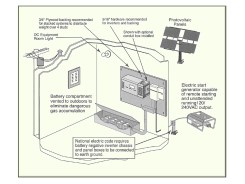 DC Input Connection
DC Input Connection
Every renewable energy system's heart and brains is the inverter. Although these are quite heavy, a 240V system may require 2 stacked inverters to generate the required voltage to operate the house's loads.
A prewired system is often a wise purchase. With factory-assembled panels approved at applicable safety standards, your electrical inspector is bound to be satisfied – and costly wiring errors are eliminated. A prewired system can offer such features as:
- A pair of sine wave inverters
- Two charge controllers wired in series
- Two excess current disconnect units
- AC wiring chassis that is used for house panel and generator connection
For your own DIY wiring, your electrical inspector may require a simplified schematic as well, but this may not fulfill the NEC/CEC code requirements. It may only form a basis for discussion with your inspector.
AC Output Connection
The inverter's AC side is familiar to any electrician. Single-phase AC voltage at a potential 120V is generated by a black (hot) wire with one white (neutral) return wire and a safety ground. A 240V supply configuration calls for another black (hot) wire. The first hot wire is known as Line One while the second is known as Line Two. Systems requiring a 240V supply need two inverters in a synchronized stack connection to generate the supply (120 + 120V = 240V).
Wiring panels in residential homes are designed for a 240V supply whereas homes requiring just 120V feeds may add a jumper wire to the panel, adding one 120V supply to the electrical panel's "legs". This prevents direct connection of 240V loads to the home's supply panel. However, a step-up transformer can be used to convert a 120V supply to a 240V supply for specific appliances and well pumps. The operation cost for a huge 240V load using a transformer is much less than stacking a second inverter but, should your house load exceed the capacity of a large inverter, a second transformer connected to the first inverter is required to generate the 240V output needed.